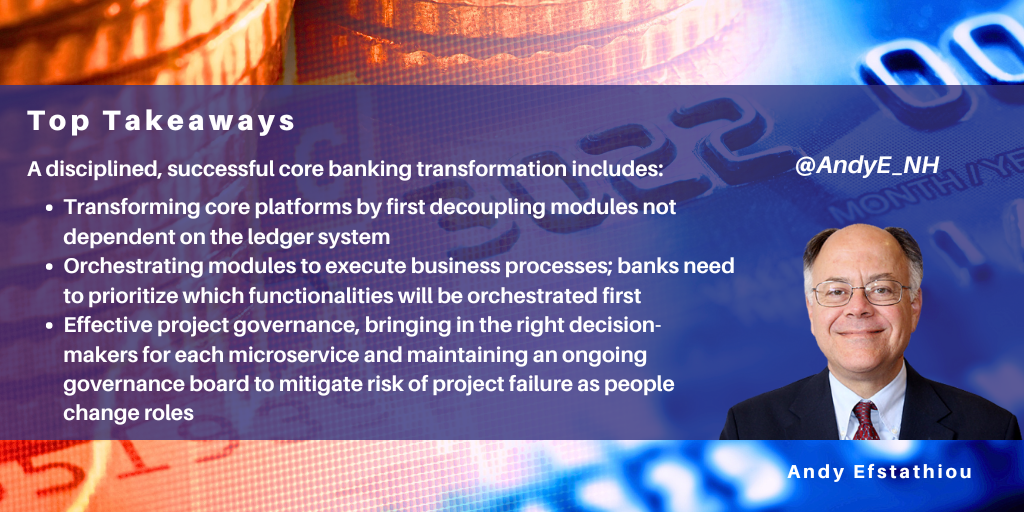Search posts by keywords:
Filter posts by author:
Related NEAT Reports
Other blog posts
posted on Oct 03, 2024 by Andy Efstathiou

In July, I published a blog outlining the latest evolving practices in core banking platform transformation. In this new blog, I outline Capgemini's approach to addressing core banking transformation challenges with its clients.
The imperative of platform transformation
Demand for core banking platform transformation continues to proliferate to enable banks to:
- Reduce their operational costs
- Meet customer expectations and increase C-SAT
- Migrate operations to the cloud
- Enable FinTech functionality, including AI and GenAI
- Increase operational agility and bring new offerings to market faster
- Integrate operations into the emerging digital ecosystem and comply with open banking requirements
- Achieve faster and more accurate adoption of changing compliance requirements
- Improve risk management capabilities
- Achieve effective international expansion.
However, bankers are reluctant to start transformation projects due to many key challenges, including:
- Difficulty in running an operation environment while undertaking a renovation project
- High risk of project failure leading to career failure
- Complexity, cost, and long timelines to run a project
- Limited access to skilled resources to execute a project.
Capgemini’s approach to core banking transformation
Capgemini has developed a disciplined core banking transformation methodology to address the challenges to achieving a successful transformation based on six critical success factors. It addresses each of these success factors in its engagements as follows:
Effective governance model:
A project governance model must enable project lifecycle continuity. The governance team must include all relevant stakeholders, including the IT group, LOB owners, and third-party service providers. Bringing in the right decision-makers for each microservice is critical to keeping a project on track. Retaining an active governance board will mitigate the risk of project failure over time as people change roles.
Identifying functionalities embedded in the core platform:
Most legacy systems have poor functionality documentation. Banks need to identify functionalities, dependencies, and integrations. BIAN is the standard reference for an industry-standard banking framework. This process needs to be executed with speed and accuracy. Capgemini employs its IPs: CAP360, a legacy code analyzer, and BREAD, a GenAI legacy rules extractor. These tools typically deliver a 40% cost reduction in identifying functionalities versus manual identification.
Sequencing the decomposition of functionalities:
Their dependence on ledger systems must drive the sequencing of pulling out functions into modules. Banks should begin by decoupling systems, such as customer management, where multiple functionalities converge to deliver service. The second set of functions to be decoupled are the ones not dependent on ledger systems (e.g., compliance and payments). Finally, the bank should decouple functions dependent on the ledger systems.
Prioritizing orchestration investments:
A microservices environment needs to be able to link the modules to execute business processes. Rolling out an orchestrator requires prioritizing which functionalities to orchestrate first and what customization to build into the orchestrator.
Reinventing the target operating model:
To reinvent and execute a new operating module, the bank must assign the right team to own and manage individual modules continuously. It needs to coordinate how teams work to enable collaboration across modules and align their development roadmaps.
Linking business value to the transformation journey:
Identifying, implementing, and reporting agreed-upon KPIs and SLAs enables the stakeholders to remain committed to the project and identify remedies if objectives are not met.
Case study
Capgemini recently undertook a core banking transformation project for a tier-one global financial institution offering retail, wealth, corporate, and SME banking services in 50 worldwide markets.
Challenges:
- Long time-to-market for new bank products
- Higher customer servicing costs and inability to meet customer expectations due to a lack of digital banking capabilities
- Increasing inefficiency and high maintenance costs of heterogeneous and end-of-life legacy system operations
- The need to componentize a microservice-based architecture to be able to bring in best-of-breed modules
- Inflexibility of existing system.
Scope of services provided:
To support the bank’s discovery phase and baseline the operations architecture, Capgemini delivered architecture components including:
- Capability model covering all the capabilities aligned to the BIAN model
- Requirements catalog covering 2000 requirements aligned to the capability model
- Baselined scope, defining the markets, products, processes, and integrations to be covered
- Architectural blueprint covering designs for all infrastructure components.
Capgemini set up a Design authority covering:
- Architecture principles, critical design decisions, RAID Log, and non-functional requirements
- Data migration and coexistence strategy, migration options, co-existence scenarios, reconciliation and cut-over approach
- Minimum Viable Product (MVP ) definition approach and sample MVPs
- Roadmap for the next phase of architecture and design
- Functional, nonfunctional, and architectural inputs to the vendor selection RFI for selecting a new core product vendor.
Benefits:
- Defined core and non-core capabilities with ownership agreed with 50 teams across the globe for delivering non-core capabilities
- Employed a BIAN-aligned capability framework and a roadmap to define BIAN-aligned microservices
- Developed a global technology architecture that identified the applications that will deliver non-core functionalities
- Enabled componentized modules, which can be extended to all the bank brands and accommodate local requirements
- Identified existing initiatives the bank will need to change to align with the core banking transformation initiative
- Developed an operational drivers value map to identify the go-to-market proposition for the first MVP
- Identified the core banking product vendors with whom the bank would like to send an RFP
- Delivered a platform and technology perspective for the target state reference architecture
- Delivered a detailed design for the core banking transformation program.
Conclusions
In summary, most banks are pursuing a hollow-the-core strategy for core banking transformation. However, the success of that approach is dependent on bringing all relevant stakeholders to oversee the project and the ongoing evolution of operations. Rigorous prioritization of module sequencing based on business goals and process dependencies will drive value enablement; and orchestrating technology modules and operations units will deliver value to customers.
